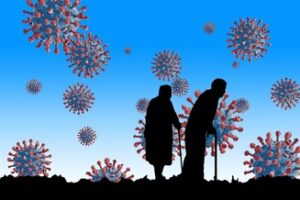NSF Convergence Accelerator Track J: Towards a Disaster Resilient Food System
The focus of this Phase 1 Convergence Accelerator award is to develop Food Forecast, a decision support platform that provides actionable information to improve post-disaster food insecurity.
Learn more on the project website or watch the project video
Funder: National Science Foundation, Award # 2236058
Project Team:
Lauren Clay (PI)
Kerstin Schreiber, Project Manager & Postdoctoral Research Associate
Jill Waity, Chris Prentice, Joe Long, Avinash Geda, and Manoj Vanajakumari, University of North Carolina Wilmington
Ashlea Milburn, University of Arkansas
NSF CAREER: Bolstering Food System Resilience to Reduce the Human Impacts of Disaster
The focus of this Faculty Early Career Development (CAREER) Program award is to advance the science of food environments and enhance the mitigation and adaptation of social and built environment systems to disasters by bolstering food security and the resilience of food systems. Food is a basic need for human survival and the ability of social systems to meet this need in disaster situations is compromised when our homes, businesses and other structures are damaged and lifelines disrupted. While elements of the various social and built environmental systems that make up the broader food environment as well as food security issues have been studied by various disciplines, a comprehensive, systematic approach has yet to be applied and tested in disaster settings. The overall objectives of this research are to develop a model of the Food Environment in Disasters (FED) along with theory-based tools to support food system resilience. The development of this model and associated tools facilitates a clearer understanding and monitoring of food availability, acceptability, and accessibility to enhance our understanding of the causes, consequences, and health effects of food environment disruption in disasters. This work contributes to NSF’s mission to promote the process of science by developing and validating a new theoretical model and associated metrics on food environment disruption and food security following disasters. The products of this research will advance national health, prosperity, and welfare by supporting improved food security and food system functioning following disasters.
Funder: National Science Foundation, Award #2225665
Project Team: Lauren Clay (PI)

Photo credit: Lauren Clay
Developing and Validating a Disaster Food Security Scale
Disaster and environmental disruptions are increasing in frequency and severity due to global climate change. While much is known about food systems and food security in non-disaster times, much less is understood about the impacts of disasters on the local food environment and how people navigate getting food when their homes and communities are severely disrupted.
Currently, the United States Department of Agriculture (USDA) monitor food security – whether households have enough food to eat – they primarily monitor whether people have enough money for food. After a disaster, if your home is damaged and you don’t have a working kitchen to store and prepare food, having enough money is not the only challenge to getting enough food to eat.
This study looks at how we can better measure food insecurity following disasters – when you experience other barriers to food security besides not having enough money. Some examples of barriers we are looking at include physical barriers to food sources such as damaged roads, food availability such as store closures, and appropriate foods that you can eat without extensive kitchen facilities to prepare.
Learn about the study results: Presentation at USDA Conference
Funder: Tufts University/USDA
Project Team: Lauren Clay (PI); Stephanie Rogus, NMSU; Meredith Niles, University of Vermont; Nadia Koyratty, Post-Doctoral Research Associate, UMBC
Science Advisory Group: Anna Josephson, University of Arizona; Roni Neff & Erin Biehl, Center for a Livable Future, Johns Hopkins University; Rachel Zack, Greater Boston Food Bank; Uriyoan Cólon-Rámos, George Washington University; Azmal Hossan, Colorado State University
NSF RAPID: A Multi-Wave Study of Risk Perception, Information Seeking, and Protective Action in COVID-19
Disasters most often result from hazards that can be seen such as in a hurricane where you can see rain and wind blowing trees and water rising or in an earthquake when you can feel the ground shaking and things around you moving. The COVID-19 pandemic was different, there were no visible cues of danger, the virus is invisible. Much of what we understand about disasters and risk communication and subsequent protective action includes relying on visible cues. This study investigates risk perception and protective action during COVID-19, where there are no visible cues of the hazard. For one year, households in New York, Louisiana, and Washington were surveyed about their experiences with the pandemic providing snapshots of risk perceptions and behaviors over the course of the first year of the pandemic. From these surveys we will examine where people got their information from, their understanding and perceptions of the pandemic, and their behaviors. From this, we will be able to learn how people made sense of the pandemic and navigated the first year for their households.
To learn more about results of this study, check out this research brief on risk perception, information seeking, and protective actions.
Funder: National Science Foundation Award # 2028412
Project Team: Samantha Penta (PI), SUNY Albany; Lauren Clay (Co-PI), UMBC; Amber Silver, SUNY Albany
